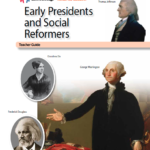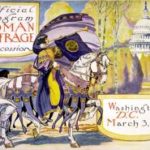This lesson looks at the historical context of women’s suffrage, tactics used in the movement, and different perspectives of the suffrage movement.
Early Presidents (CKHG Unit)

This unit (first half of Early Presidents and Social Reformers) focuses on the first seven presidents of the United States. Across 9 lessons, students learn about how the early presidents organized the federal government, built a national capital, directed a second war with Great Britain, more than doubled the size of the country, and formulated a “hands-off” foreign policy in the Western Hemisphere.
Women Before the American Revolution
This short video explores the limited rights of women prior to the American Revolution. According to the idea of femme covert, women were legally and politically subservient to their husbands. Married women could not own property and all women were considered irrelevant to the political sphere. Professor Rosemarie Zagarri notes that 80% of the freemen in the colonies could vote (as compared to 20% in Great Britain), but suffrage was still limited to men.
Grade 9-10 What was Most “Revolutionary” About the Declaration of Independence?
This lesson will use a close reading of the Declaration of Independence to explore the American colonists’ reasons for separating from Great Britain. By the conclusion of the lesson, student will understand the role of the Declaration in encouraging support for American Independence, and in laying the groundwork for a new system of government and individual rights.
Grade 6 “When in the Course of Human Events:” Introducing the Declaration of Independence
This lesson will use a close reading of the Declaration of Independence to explore the American colonists’ reasons for separating from Great Britain. By the conclusion of this lesson, students should be able to identify the specific arguments made for Independence. Students will assess the objectives of the Declaration and identify if and how the drafters may have fallen short of some of their stated goals.
Sisters of Suffrage: British and American Women Fight for the Vote

The dominant narrative of the entire women’s suffrage movement begins and ends with the United States and Britain. Hundreds of thousands of women petitioned, canvassed, lobbied, demonstrated, engaged in mass civil disobedience, went to jail, and engaged in hunger strikes in a seventy-five-year ongoing political and social struggle for the right to vote. Free registration for students and teachers required to access resource.